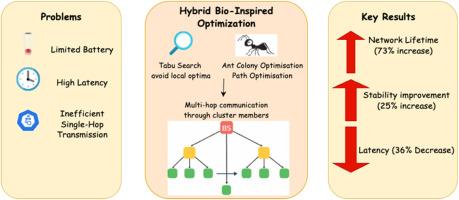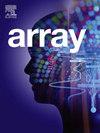Hybrid bio-inspired optimization based routing protocol for enhancing data transmission in clustered network
IF 4.5
Q2 COMPUTER SCIENCE, THEORY & METHODS
引用次数: 0
Abstract
The Internet of Things (IoT) incorporates Wireless Sensor Networks (WSNs) to gather data in real time for a range of applications, including smart homes and healthcare. Energy efficiency is an essential concern considering sensor nodes have limited energy resources. Early node failures, network segmentation, and reduced quality of service (QoS) are driven by constant and uneven energy consumption among sensor nodes, particularly during data transmission and cluster head (CH) processes. For addressing this issue, the current study proposes a hybrid optimization approach for a clustering protocol that mitigates transmission latency and optimises energy efficiency by integrating bi-objective Tabu Search and Ant Colony Optimization (ACO). The primary goals include to extend the network lifetime via efficient data transmission and the most optimal possible cluster head (CH) selection. In two deployment scenarios, the protocol is simulated in MATLAB and assessed based on residual energy, transmission delay, network stability, and lifetime. Results indicate a 73 % lifetime increase, a 25 % improvement in network stability, and a 36 % decrease in delivery latency when compared to GWO, ESO, GECR, and LEACH. The proposed protocol surpasses other protocols in extending WSN capabilities in Internet of Things systems.

基于混合生物优化的路由协议增强集群网络中的数据传输
物联网(IoT)集成了无线传感器网络(wsn),可为包括智能家居和医疗保健在内的一系列应用实时收集数据。考虑到传感器节点的能源资源有限,能源效率是一个重要的问题。早期节点故障、网络分段和服务质量(QoS)下降是由传感器节点之间持续且不均匀的能量消耗驱动的,特别是在数据传输和簇头(CH)过程中。为了解决这一问题,本研究提出了一种混合优化聚类协议的方法,通过集成双目标禁忌搜索和蚁群优化(ACO)来减轻传输延迟并优化能源效率。主要目标包括通过有效的数据传输和最优的簇头(CH)选择来延长网络生命周期。在两种部署场景下,在MATLAB中对协议进行仿真,并根据剩余能量、传输延迟、网络稳定性和生存期对协议进行评估。结果表明,与GWO、ESO、GECR和LEACH相比,寿命增加了73%,网络稳定性提高了25%,传输延迟减少了36%。该协议在物联网系统中扩展WSN功能方面优于其他协议。
本文章由计算机程序翻译,如有差异,请以英文原文为准。
求助全文
约1分钟内获得全文
求助全文

 求助内容:
求助内容: 应助结果提醒方式:
应助结果提醒方式:


